
Papua is a province of Indonesia, comprising the northern coast of Western New Guinea together with island groups in Cenderawasih Bay to the west. It roughly follows the borders of Papuan customary region of Tabi Saireri, and is divided into eight regencies and one city (kota), the latter being the provincial capital of Jayapura.
Matrilineality is the tracing of kinship through the female line. It may also correlate with a social system in which each person is identified with their matriline, their mother's lineage, and which can involve the inheritance of property and titles. A matriline is a line of descent from a female ancestor to a descendant of either gender in which the individuals in all intervening generations are mothers. In a matrilineal descent system, an individual is considered to belong to the same descent group as their mother. This ancient matrilineal descent pattern is in contrast to the currently more popular pattern of patrilineal descent from which a family name is usually derived. The matriline of historical nobility was also called their enatic or uterine ancestry, corresponding to the patrilineal or "agnatic" ancestry.

The Korowai, also called the Kolufo, live in southeastern Papua in the Indonesian provinces of South Papua and Highland Papua. Their tribal area is split by the borders of Boven Digoel Regency, Mappi Regency, Asmat Regency, and Yahukimo Regency. They number about 4000 to 4400 people.
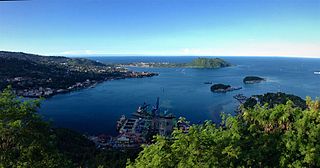
Jayapura is the capital and largest city of the Indonesian province of Papua. It is situated on the northern coast of New Guinea island and covers an area of 940.0 km2 (362.9 sq mi). The city borders the Pacific Ocean and Yos Sudarso Bay to the north, the country of Papua New Guinea to the east, Keerom Regency to the south, and Jayapura Regency to the west.
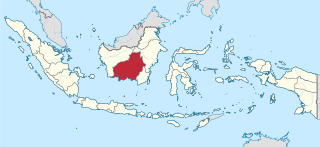
Central Kalimantan is a province of Indonesia. It is one of five provinces in Kalimantan, the Indonesian part of Borneo. It is the largest province in Indonesia by area since 2022, bordered by West Kalimantan to the west, South Kalimantan and East Kalimantan to the east, Java Sea to the south and is separated narrowly from North Kalimantan and Malaysia by East Kalimantan's Mahakam Ulu Regency. Its provincial capital is Palangka Raya and in 2010 its population was over 2.2 million, while the 2020 Census showed a total of almost 2.67 million; the official estimate as at mid 2023 was 2,774,747, and was projected to rise to 2,809,700 at mid 2024.

West Papua, formerly Irian Jaya Barat, is an Indonesian province located in Indonesia Papua. It covers most of the two western peninsulas of the island of New Guinea: the eastern half of the Bird's Head Peninsula and the whole of the Bomberai Peninsula, along with nearby smaller islands. The province is bordered to the north by the Pacific Ocean, to the west by Southwest Papua Province, the Halmahera Sea and the Ceram Sea, to the south by the Banda Sea, and to the east by the province of Central Papua and the Cenderawasih Bay. Manokwari is the province's capital and largest city. With an estimated population of 569,570 in mid-2023, West Papua is the least populous province in Indonesia after South Papua, following the separation off in 2022 of the western half of the Bird's Head Peninsula to create the new province of Southwest Papua, containing 52% of what had been West Papua's population. Its population density is similar to Russia.
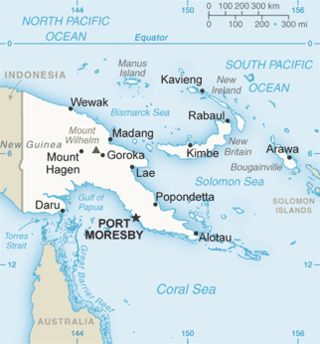
The Gulf of Papua is located in the southern coast region of New Guinea. It has a total surface area of 70,400 km2 (27,200 sq mi).

Kula, also known as the Kula exchange or Kula ring, is a ceremonial exchange system conducted in the Milne Bay Province of Papua New Guinea. The Kula ring was made famous by Bronisław Malinowski, considered the father of modern anthropology. He used this test case to argue for the universality of rational decision-making and for the cultural nature of the object of their effort. Malinowski's seminal work on the topic, Argonauts of the Western Pacific (1922), directly confronted the question, "Why would men risk life and limb to travel across huge expanses of dangerous ocean to give away what appear to be worthless trinkets?" Malinowski carefully traced the network of exchanges of bracelets and necklaces across the Trobriand Islands, and established that they were part of a system of exchange, and that this exchange system was clearly linked to political authority.
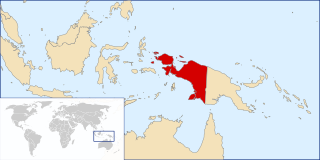
Western New Guinea, also known as Papua, Indonesian New Guinea, and Indonesian Papua, is the western half of the island of New Guinea, formerly Dutch and granted to Indonesia in 1962. Given the island is alternatively named Papua, the region is also called West Papua. It is one of the seven geographical units of Indonesia in ISO 3166-2:ID.

The Lani are an indigenous people in Puncak, Central Papua and Lanny Jaya, Highland Papua, usually labelled 'Western Dani' by foreign missionaries, or grouped—inaccurately—with the Dani people who inhabit the Baliem Valley to the east.
Agwu Nsi is the Arusi of divination. The earth is inhabited by Agwu, a spiritual entity that goes beyond a mere force. Agwu possesses intellectual and volitive faculties, exerting significant influence on human affairs. Revered as the patron spirit of the dibia (diviner-healer) and the source of inspiration for exceptionally talented individuals, Agwu is closely associated with humanity's pursuit of fulfillment in society. It is believed that Agwu plays a role in enforcing various determinations, with the sick attributing their fate to him, creatively gifted individuals crediting his benevolent influence, and dibia being believed to be possessed by him. This page explores the nature of Agwu's possession, considering it as the culmination of his impact on human beings and examining its manifestation in individuals' experiences. Despite the transformative effects of modernization, Agwu's influence persists. Agwu is also known by other names such as Agwuisi and Agwunsi. While the popularity of these names may vary across different communities, there are no significant etymological differences among them. The simpler form, Agwu, encapsulates the complete essence of the concept. The suffixes isi and nsi, denoting head/first and poison respectively, serve as onomatopoeic expressions representing specific orders of relationships, characteristics, and effects associated with the spirit. Agwu is perceived as embodying tendencies that exhibit drastic moral opposites, often described in dialectical terms such as aka nri agwu (good/positive) and aka agwu (negative); ikenga agwu (support) and uruala agwu (subversion). Unlike other spiritual entities, Agwu is not characterized by a fixed inclination towards aiding or punishing, good or evil. Similar to spirits, Agwu has the capacity to both aid and punish. However, unlike them, he does not exhibit a consistent inclination in either direction.

The Marind or Marind-Anim are an ethnic group of New Guinea, residing in the province of South Papua, Indonesia.

New Guinea is the world's second-largest island, with an area of 785,753 km2 (303,381 sq mi). Located in Melanesia in the southwestern Pacific Ocean, the island is separated from Australia by the 150-kilometre wide Torres Strait, though both landmasses lie on the same continental shelf, and were united during episodes of low sea level in the Pleistocene glaciations as the combined landmass of Sahul. Numerous smaller islands are located to the West and East. The island's name was given by Spanish explorer Yñigo Ortiz de Retez during his maritime expedition of 1545 due to the resemblance of the indigenous peoples of the island to those in the African region of Guinea.

The Yam languages, also known as the Morehead River languages, are a family of Papuan languages. They include many of the languages south and west of the Fly River in Papua New Guinea and Indonesian Western New Guinea.

The Iatmul are a large ethnic group of about 10,000 people inhabiting some two-dozen politically autonomous villages along the middle Sepik River in Papua New Guinea. The communities are roughly grouped according to dialect of the Iatmul language as well as sociocultural affinities. The Iatmul are best known for their art, men's houses, male initiation, elaborate totemic systems, and a famous ritual called naven, first studied by Gregory Bateson in the 1930s. More recently, Iatmul are known as a location for tourists and adventure travellers, and a prominent role in the 1988 documentary film Cannibal Tours.

The Brazza River is a river in Papua province, Indonesia. The Brazza River has its source at over 3000 meters of elevation in the Jayawijaya or Maoke Mountains of central Papua in Yahukimo Regency and flows south to the lowland rainforests of Asmat Regency before meeting the Pulau River, which flows southeast to the Arafura Sea.
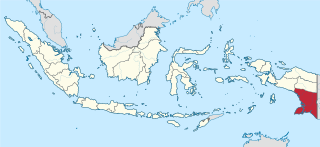
South Papua, officially the South Papua Province, is an Indonesian province located in the southern portion of Papua, following the borders of the Papuan customary region of Anim Ha. Formally established on 11 November 2022 and including the four most southern regencies that were previously part of the province of Papua and before 11 December 2002 had comprised a larger Merauke Regency, it covers a land area of 129,715.02 km2, about the same area as Pennsylvania. This area had a population of 513,617 at the 2020 Census, while the official estimate as at mid 2023 was 537,973, making it the least populous province in Indonesia.

The Indonesia–Papua New Guinea border is the international border between Indonesia and Papua New Guinea. The border, which divides the island of New Guinea in half, consists of two straight north–south lines connected by a short section running along the Fly River, totalling 824 km (512 mi). The boundary separates Papua, Highland Papua, and South Papua provinces of Indonesia from Sandaun and Western provinces of Papua New Guinea.

Central Papua, officially the Central Papua Province is an Indonesian province located in the central region of Western New Guinea. It was formally established on 11 November 2022 from the former eight western regencies of the province of Papua. It covers an area of 61,072.91 km2 and had an officially estimated population of 1,452,810 in mid 2023. It is bordered by the Indonesian provinces of West Papua to the west, the province of Papua to the north and northeast, by Highland Papua to the east, and by South Papua to the southeast. The administrative capital is located in Wanggar District in Nabire Regency, although Timika is a larger town.

Highland Papua is a province of Indonesia, which roughly follows the borders of the Papuan customary region of Lano-Pago. It covers an area of 51,213.33 km2 (19,773.58 sq mi) and had a population of 1,448,360 according to the official estimates as at mid 2023.



















